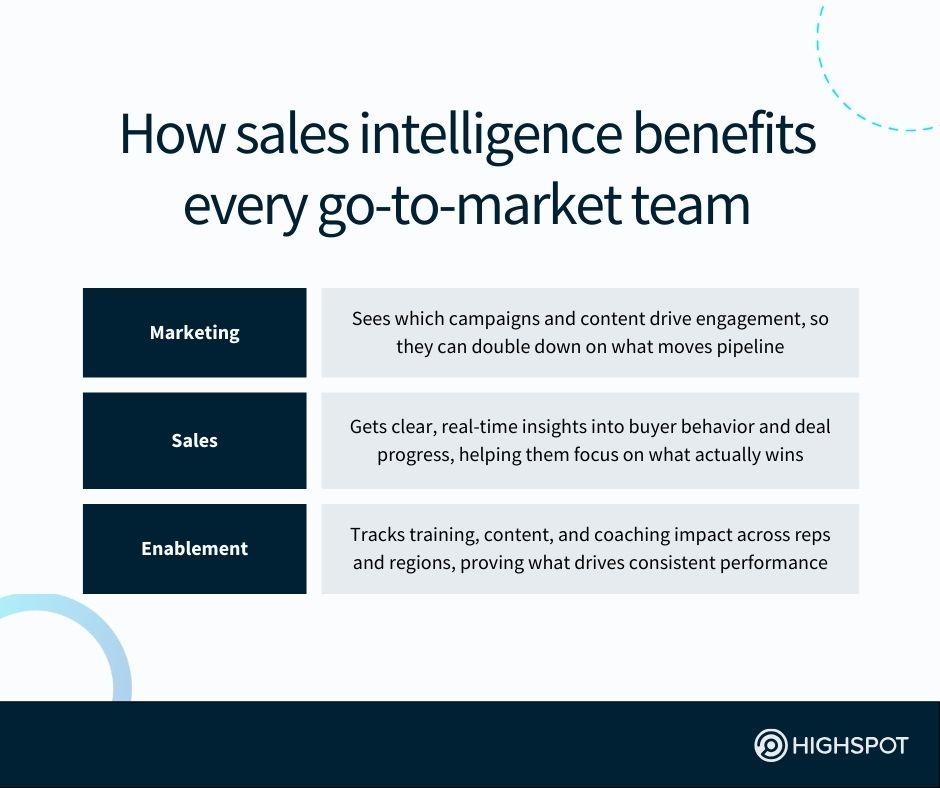Key Takeaways
- Cutting-edge sales intelligence tools turn noise into clarity. It shows what’s working, what’s not, and what to do about it—fast.
- The best sales tools that offer intel into sales representatives’ engagement efforts also supply AI-powered insights that help your GTM teams move with precision, make better decisions, and tighten execution.
- Sales intelligence tools you invest in must connect your reps, content, and strategy so you can scale performance, not just activity.
Go-to-market teams at companies across industries fly blind far too often.
Your BDRs run plays that don’t land. Your GTM leaders push initiatives without knowing what’s working. And RevOps is stuck piecing together reports that don’t tell the full story.
Sales intelligence flips that script—and provides a competitive advantage.
More specifically, it gives you the full, 360-degree view—what’s happening across reps, buyers, and deals—so you can spot what’s working, double-down fast, and, just as importantly, cut what’s not before it becomes a drag on growth.
The issue is not all sales intelligence tools actually help your sales, marketing, and enablement teams act on data and insights (let alone quickly). They tell you something happened, but not why—and certainly not what to do next.
What you need are actionable insights into your entire sales process that:
- Tie content, training, coaching, and buyer engagement all together
- Show you where deals stall and the reason behind their stagnation
- Help you coach with precision and invest in what moves the needle
With the right sales intelligence tools embedded in your GTM tech stack, you can see how your sales professionals are actually selling—and what your best reps do differently.
As long as you have accurate and reliable data, an AI-powered, data-driven approach can surface patterns in rep behaviour, content usage, and what buyers respond to.
That means marketing, enablement, and sales can finally row in the same direction. Going to market gets faster, smarter, and more aligned, and reps win more of the time.
Every enterprise sales and revenue team needs that edge, because when you can see what exactly drives performance and impacts business success, you can scale it.
What is sales intelligence?
Sales intelligence refers to the ability to see everything that contributes to or detracts from go-to-market performance across your GTM teams and, in turn, revenue growth for your business. It connects the dots between buyer engagement, rep behaviour, and business outcomes so you know what works and where to focus.
Sales intelligence isn’t just interactive dashboards or static reports. It’s real-time, actionable insight that helps you lead with facts, not gut instinct. The best sales intelligence goes beyond activity tracking and gives you visibility into execution.
Sales intelligence FAQs
Where should insights from sales intelligence tools be surfaced for reps?
Sales intelligence should live inside seller workflows, embedded in CRM records, enablement platforms, and tools reps already use daily across active opportunities. Leveraging AI sales agents like Highspot’s Deal Agent can help your go-to-market organisation surface key insights directly in context, helping SDRs take the next-best actions in current opps without having to jump across tools or disrupting deal flow.
How does sales intelligence influence consistent B2B revenue growth?
Sales intelligence gives revenue teams shared visibility into buyer context, deal health, and market patterns across the funnel. It replaces fragmented views with unified insight, helping sellers prioritise opportunities, align outreach, and operate from informed context rather than outdated data.
Which types of AI sales intelligence tools support modern GTM teams?
Sales intelligence tools with AI analyse large volumes of account and content-usage data to reveal patterns related to seller performance and buyer behaviour. Connecting these solutions with your revenue enablement, sales engagement, and CRM systems provides a holistic, 360-degree view of all previously engaged opportunities and what led to closed-won, closed-lost, and no-decision deals.
How do sales intelligence platforms elevate seller performance at scale?
Sales intelligence tools improve seller performance by consolidating account data, buyer signals, and deal context into a single workflow. Sellers spend fewer cycles searching for information and gain clearer direction on where to focus, enabling consistent execution across complex buying environments.
How do sales intelligence tools fit within modern GTM technology stacks?
Leading sales intelligence platforms integrate with CRM, enablement, and analytics systems to extend existing workflows rather than replace them. Seamless integration ensures data flows consistently across tools, giving revenue teams a reliable foundation for planning, selling, and performance analysis.
Can sales intelligence help reduce deal slippage in late-stage pipeline?
Sales intelligence reduces slippage by showing which deals are losing momentum, why buyers disengage, and which factors have historically stalled decisions. By connecting seller activity with buyer response patterns, teams can intervene earlier and reinforce urgency before deals fall behind.
How AI-powered sales intelligence drives stronger go-to-market performance
With proven sales intelligence software, you can get answers to questions like:
- Are your sales representatives using the right content across the entire sales cycle?
- Can sales enablement see which sales professionals are actively utilising their content?
- Are your sales leaders and managers instituting the right types of sales plays for reps?
- Do marketing’s efforts around lead generation help to build strong sales pipelines?
- Is your entire GTM team delivering relevant messaging that’s leading to high win rates?
That’s the level of clarity go-to-market teams like yours need to move fast, fix what’s broken, and scale what wins within your respective sales process so your sales teams can better turn potential customers into high-paying clients.
“Marketing, sales, and customer success teams tend to work in entrenched silos with their own processes and metrics, few of which have a meaningful impact on the bottom line,” Boston Consulting Group recently wrote.
With the right sales intelligence platform, you don’t have to worry about these silos persisting. Instead, your GTM operation gets a unified, comprehensive view of where things are going well in your sales process and what needs repair.

Benefits of sales intelligence data
“Data-driven decisions rely on quantifiable information, reducing bias and ensuring choices are made based on consistent criteria versus personal perceptions,” Forbes contributor and business expert Naveen Singh recently wrote.
“In other words, the data doesn’t lie,” he continued.
Your sales, marketing, and enablement data is the lifeblood of your GTM organisation—and sales intelligence tools are the mediums through which you can make sense of that data. Some key advantages the tech provides include:
Complete data accuracy and zero data latency
Sales operations run on real-time, trustworthy data. When there’s no delay in data updates in your (presumably) extensive database network, your GTM teams can respond to what’s happening now, not what happened last week.
Clean, complete, centralised intel across the sales process helps your sales professionals, in particular, stay ahead of buyer behaviour. No more stale reports. No more guesswork.
Just fast, informed action that improves efficiency in every stage of the funnel.
Unified customer intent data and buying signals
When buying intent data that reveals buyer intent signals (based on their recent engagement with reps and company website actions they take) live in one place, sales reps don’t end up wasting time chasing cold leads with sparse CRM contact details.
Just the opposite, in fact: They focus on potential customers who are ready to engage. Unified prospect data gives you the full picture: what your buyers care about, which content they engage with, and how to advance them through the sales cycle.
Actionable insights into all reps’ sales pipelines
Visibility drives better sales performance. With centralised intel—and, ideally, AI-powered insights—your sales leaders can see every rep’s pipeline in detail—what’s moving, what’s stalled, and where support is needed. This helps GTM teams spot patterns, optimise your sales strategy together, and take action fast.
The result? More effective sales efforts, stronger sales development for reps (especially new hires learning the ropes), and better outcomes.
Streamlined lead qualification and prioritisation
Sales intelligence makes it easier for reps to review and rank the right leads. It filters out noise so your sales representatives can focus on the buyers who matter, based on their:
- Engagement data: Sales content analytics that shows where, when, and how many interactions with potential customers occur across the sales cycle
- Firmographic data: Location, industry insights, and other company details tied to a lead
- Technographic data: The software, hardware, and IT/tech infrastructure of a prospect
- Buyer intent data: Information regarding a buyer’s budget, authority, need, and timeline
With this clarity, sales spends less time digging for data and more time closing.
Aligned enablement, sales, and marketing teams
When everyone works from the same data, GTM alignment becomes a reality.
Sales reps, account executives, product and content marketers, and enablement personnel can see what’s working and enhance GTM initiatives together. Your sales intelligence tool helps everyone stay focused on the same active plays, with clear handoffs and shared KPIs, and enables them to adjust on the fly.
Historical and predictive analytics for GTM leaders
Your sales and revenue leaders need to know what happened—and what’s coming.
Getting both ‘look-back’ and ‘look-ahead’ dashboards that offer clear views into past sales performance and future forecast trends, you and other GTM decision-makers can collectively make bold, data-driven calls that keep momentum strong.
Syncing your CRM and sales intelligence tools
No go-to-market team (or company, for that matter) can execute without a CRM. But merely having a customer relationship management system isn’t enough. You also need to integrate it with your sales intelligence software to get the most out of your prospect and customer data sets for proactive sales outreach.
Contact data enrichment for more robust lead records
Consider how Highspot customers leverage our native Salesforce integration.
Highspot Sr. Pricing and Partner Ecosystem Director Mike Brophy recently took part in a webinar to discuss the rich, real-time sales intelligence our enablement platform provides GTM leaders, thanks to our direct Salesforce integration.
“You can combine not only sales and marketing content but also sales training insights within Salesforce,” Mike shared on Highspot’s Unlocking Sales Productivity with AI webinar, co-hosted with Salesforce and Skillsoft.
“This provides visibility for sales managers to see how your reps are performing—what’s been completed, in terms of training, and what hasn’t,” Mike added.
Then, you can take all that data back to Salesforce, analyse it, and see who’s performing well and who’s not and identify best practices, with the hope you are improving sales behaviours and, therefore, optimising your go-to-market initiatives.
Blended firmographic data and company data for GTM
Merging this wealth of data gives your GTM teams the edge they need to elevate their output. When you combine static info (business size, sector, headquarters) with dynamic prospect data (engagement history, current stage in the funnel, potential deal size), you get a fuller picture of every potential customer.
That means sales reps can better qualify accounts, personalise outreach, and tailor messaging based on what actually matters to the buyer. It also helps sales professionals avoid wasting time on poor-fit leads that will never convert.
For revenue leaders, this boosts forecast accuracy and sharper territory planning.
For marketing and enablement, it leads to more relevant content and campaigns.
And for the entire sales team, it’s a fast-track to greater sales efficiency, stronger alignment, and better sales performance. Real insight. Real action. No guesswork.
The best sales intelligence tools for 2025
You know what the top sales intelligence tools bring to the table for your GTM operation. Now, it’s worth exploring what specific offerings are out there to help your team thrive.
Best sales intelligence tool for tracking go-to-market enablement, training, and coaching activities
Highspot gives GTM teams a clear line of sight from enablement to revenue.
- With AI-powered insights from Highspot Copilot, Highspot Agents, and Conversation Intelligence, you can see how reps perform on sales calls, leverage content and messaging, and what skills need reinforcement.
- Scorecards surface what’s working across content, plays, training, and coaching. For example, our Initiative Scorecard sheds light on progress of key initiatives, like expansion and cross-sell campaigns and product launches.
If you want to track and improve rep behaviour in real-time and continually elevate the quality and ROI of your go-to-market programmes and activities, Highspot is for you.
Best sales intelligence solution for gaining a holistic, robust view of all customers and prospects
- Salesforce, combined with Agentforce, offers deep, contextual visibility into every customer and prospect, helping GTM teams surface relevant insights and take fast, focused action.
- Microsoft Dynamics 365 empowers reps and leaders with complete buyer and account context, making it easier to forecast, prioritise outreach, and align sales efforts to strategic goals.
Best sales intelligence platform for providing sales and marketing teams with data on shared campaigns
- HubSpot centralises campaign data, enabling sales and marketing to track prospect engagement and ID which messages and channels drive conversion across the funnel.
- Marketo connects top-of-funnel behaviour to pipeline movement, helping teams pinpoint which campaigns influence high-quality leads and accelerate decision-making.
- Eloqua offers detailed engagement tracking that fuels campaign optimisation, letting teams fine-tune efforts and better support reps with buyer-ready messaging.
Best sales intelligence system for guiding reps’ social selling for high-value accounts
- LinkedIn Sales Navigator equips reps with targeted insights on prospects’ behaviour and account activity, enabling them personalise outreach, gain buyers’ trust, and deepen engagement. Advanced search, lead recommendations, and real-time updates on buyer job changes and interests help reps stay relevant, strengthen relationships, and influence decision-makers early in the sales cycle.
Selecting your sales intelligence software
Our advice is short and sweet: Look for clarity, not clutter. Choose a sales intelligence tool that shows what’s moving the needle and what’s holding your sales efforts back—without needing five other solutions to make sense of them.
Prioritise clean, real-time data and relevance to your GTM motion. (Bonus points if it plays nice with your CRM, CMS, marketing automation, and sales engagement tools.)
Bottom line: Lean into artificial intelligence—heavily. At the end of the day, the right AI sales tools should always lighten the load for you and your team and increase the time to value for your most important GTM initiatives.




